Complete Solutions to Comprehension of chapter ARCHIVES 2 VOLUME 6 of Class 11 book with complete answers and questions
| Class 11 | PHYSICS |
| Chapter | ARCHIVES 2 VOLUME 6 |
| CENGAGE PHYSICS | Comprehension |
| Number Of Questions | 12 |
| Academic Year | 2023-24 |
Waves `y_(1) = Acos(0.5pix - 100pit)` and `y_(2)=Acos(0.46pix - 92pit)` are travelling along x-axis. (Here `x` is in `m` and `t` is in second)
(1) Find the number of times intensity is maximum in time interval of `1 sec`.03:38View SolutionWaves `y_(1) = Acos(0.5pix - 100pit)` and `y_(2)=Acos(0.46pix - 92pit)` are travelling along x-axis. (Here `x` is in `m` and `t` is in second)
(2) The wave velocity of louder sound is02:34View SolutionWaves `y_(1) = Acos(0.5pix - 100pit)` and `y_(2)=Acos(0.46pix - 92pit)` are travelling along x-axis. (Here `x` is in `m` and `t` is in second)
(3) The number of times `y_(1) + y_(2) = 0` at `x = 0` in `1sec` is06:59View SolutionTwo trains `A and B` moving with speeds `20m//s` and `30m//s` respectively in the same direction on the same straight track, with `B` ahead of `A`. The engines are at the front ends. The engine of train `A` blows a long whistle.
Assume that the sound of the whistle is composed of components varying in frequency from `f_(1) = 800 Hz` to `f_(2) = 1120 Hz`, as shown in the figure. The spread in the frequency (highest frequency - lowest frequency) is thus `320 Hz`. The speed of sound in still air is `340 m//s`.
(4) The speed of sound of the whistle is02:31View SolutionTwo trains `A and B` moving with speeds `20m//s` and `30m//s` respectively in the same direction on the same straight track, with `B` ahead of `A`. The engines are at the front ends. The engine of train `A` blows a long whistle.
Assume that the sound of the whistle is composed of components varying in frequency from `f_(1) = 800 Hz` to `f_(2) = 1120 Hz`, as shown in the figure. the spread in the frequency (highest frequency - lowest frequency) is thus `320 Hz`. the speed of sound in still air is `340 m//s`.
(5) The distribution of the sound intensity of the whistle as observed by the passengers in train `A` is best represented byView SolutionTwo trains `A and B` moving with speeds `20m//s` and `30m//s` respectively in the same direction on the same straight track, with `B` ahead of `A`. The engines are at the front ends. The engine of train `A` blows a long whistle.
Assume that the sound of the whistle is composed of components varying in frequency from `f_(1) = 800 Hz` to `f_(2) = 1120 Hz`, as shown in the figure. the spread in the frequency (highest frequency - lowest frequency) is thus `320 Hz`. the speed of sound in still air is `340 m//s`.
The spread of frequency as observed by the passenger in train `B` is03:05View SolutionWhen a particle is mass `m` moves on the `x-` axis in a potential of the from `V(x) = kx^(2)`, it performs simple harmonic motion. The corresponding thime periond is proportional to `sqrt((m)/(k))`, as can be seen easily asing dimensional analysis. However, the motion of a pariticle can be periodic even when its potential enem increases on both sides `x = 0` in a way different from `kx^(2)` and its total energy is such that the particel does not escape to infinity. consider a particle of mass `m` moving onthe `x-`axis . Its potential energy is `V(x) = omega (alpha gt 0`) for `|x|` near the origin and becomes a constant equal to `V_(0)` for `|x| ge X_(0)` (see figure)
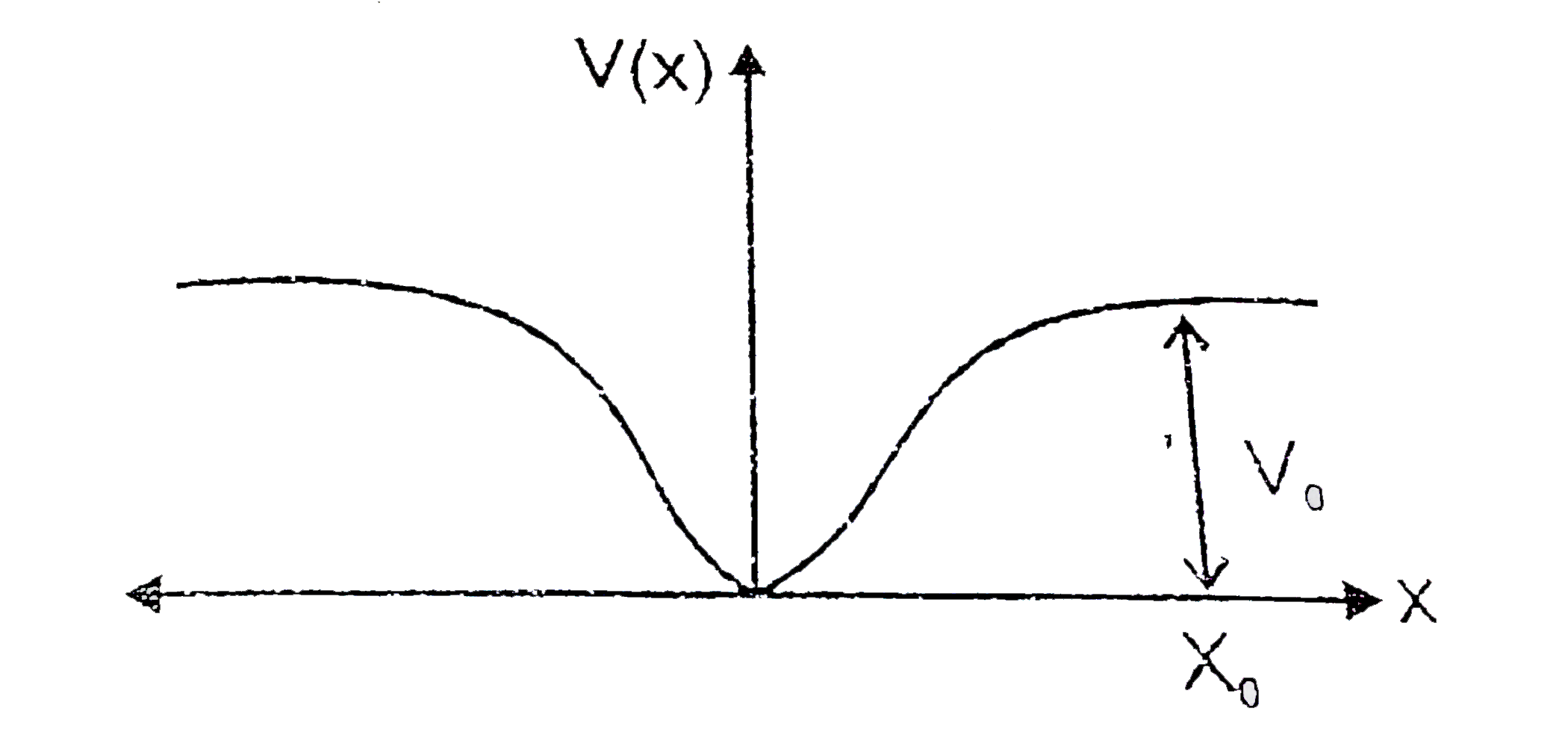
If the total energy of the particle is `E`, it will perform is periodic motion why if :03:23View SolutionWhen a particle of mass `m` moves on the x-axis in potential of the from `V(x) = kx^2` it performs simple harmonic motion. The corresponding time period is proportional to `m, k` as can be seen easily using dimensional analysis. However, the motion of a particle can be periodic even when its potential energy increases on both sides of `x = 0` in a way different from `kx^2` and its total energy is such that the particle does not escape to infinity. Consider a particle of mass `m` moving on the x-axis. Its potential energy is `V(x) = prop x^4(prop gt 0) fro |x|` near the origin and becomes a constant equal to `V_0 for |x| ge X_0` (see Fig. 8.12).
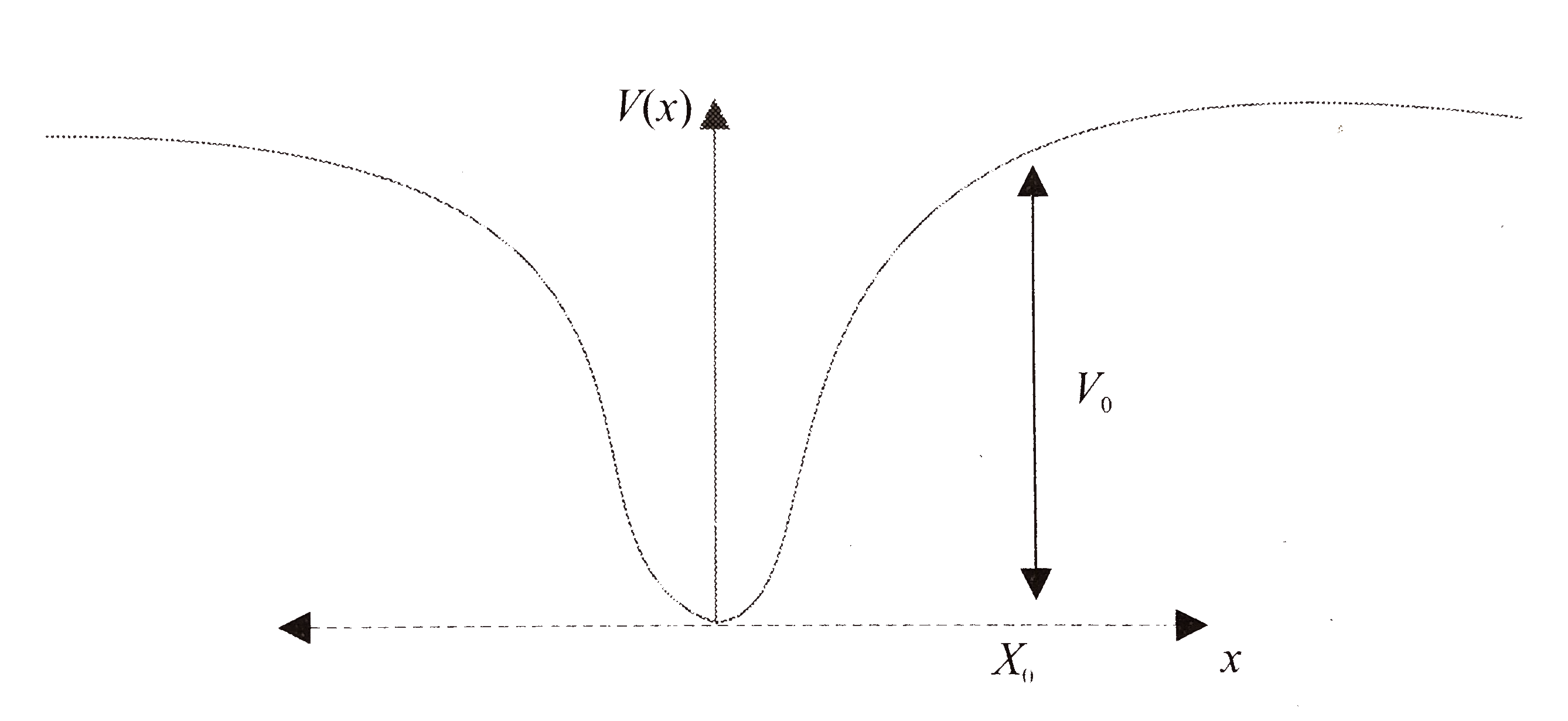
If the total energy of the particle is `E`. it will perform periodic motion only if.02:50View SolutionWhen a particle of mass m moves on the x-axis in a potential of the form `V(x) =kx^(2)` it performs simple harmonic motion. The correspondubing time period is proprtional to `sqrtm/h`, as can be seen easily using dimensional analusis. However, the motion of a particle can be periodic even when its potential energy increases on both sides of `x=0` in a way different from `kx^(2)` and its total energy is such that the particle does not escape toin finity. Consider a particle of mass m moving on the x-axis. Its potential energy is `V(x)=ax^(4)(agt0)` for |x| neat the origin and becomes a constant equal to `V_(0)` for |x|impliesX_(0)` (see figure).
 .
.
The acceleration of this partile for `|x|gtX_(0)` is
(a) proprtional to `V_(0)`
(b) proportional to.02:23View SolutionPhase space diagrams are useful tools in analysing all kinds of dynamical problems. They are especially useful in studying the changes in motion as initial position and momentum are changed. Here we consider some simple dynamical systems in one dimension. For such systems, phase space is a plane in which position is plotted along horizontal axis and momentum in plotted along vertical the axis.
The phase space diagram is `x(t)` vsersus `p(t)` curve in this plane. The arrow on the curve indicates the time flow. For example, the phase space space diagram for a particle moving with constant velocity is a straight line as shown in (Fig. 8.13). We use the sign convention in which position or momentum upwards (or to right) is positive and downwards (or to left) is negative.
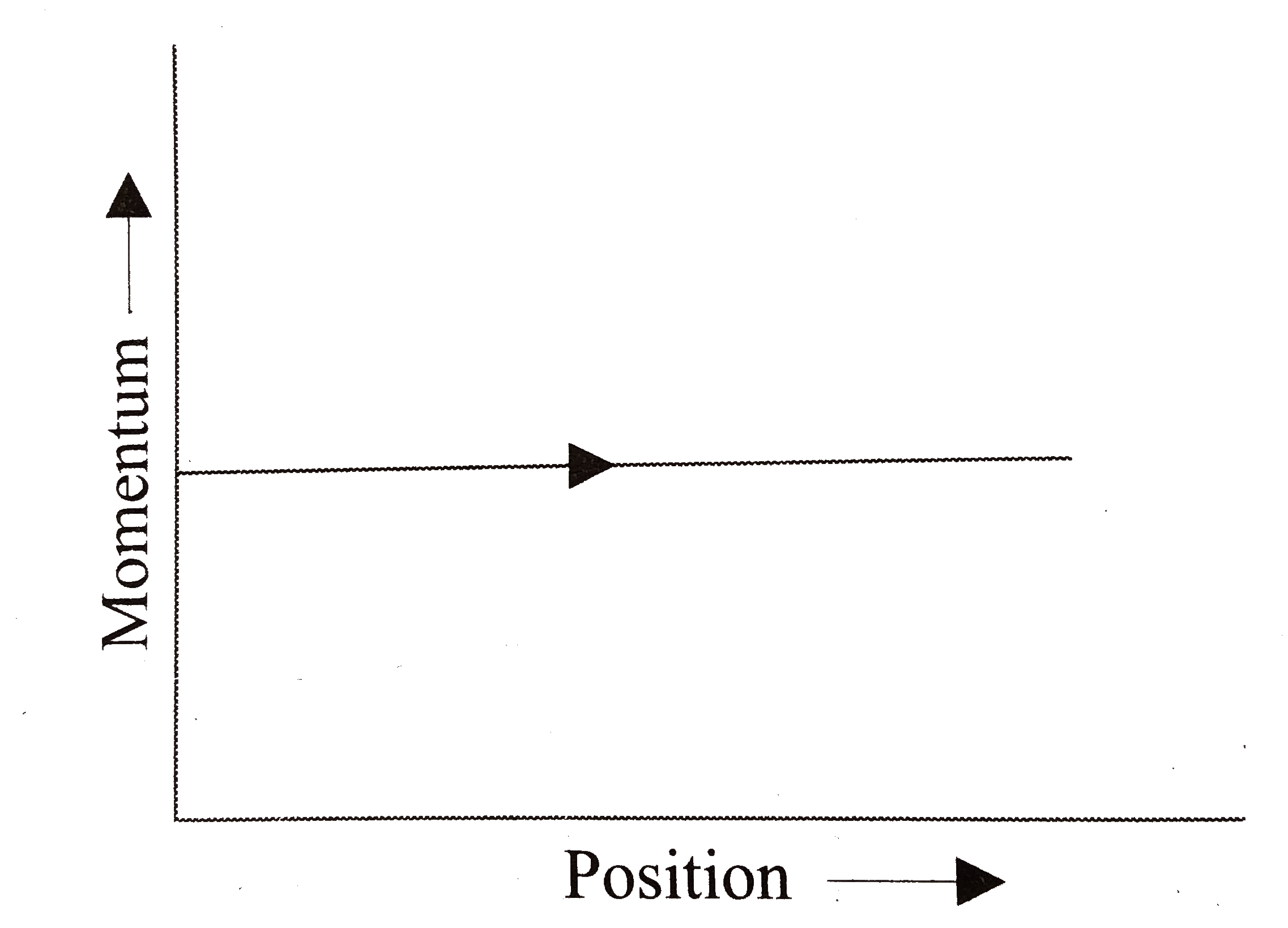 .
.
The phase space diagram for simple harmonic motion is a circle centred at the origin. In (Fig. 8.14), the two circles represent the same oscillator but for different initial conditions, and `E_1 and E_2` are the total mechanical energies respectively. Then.
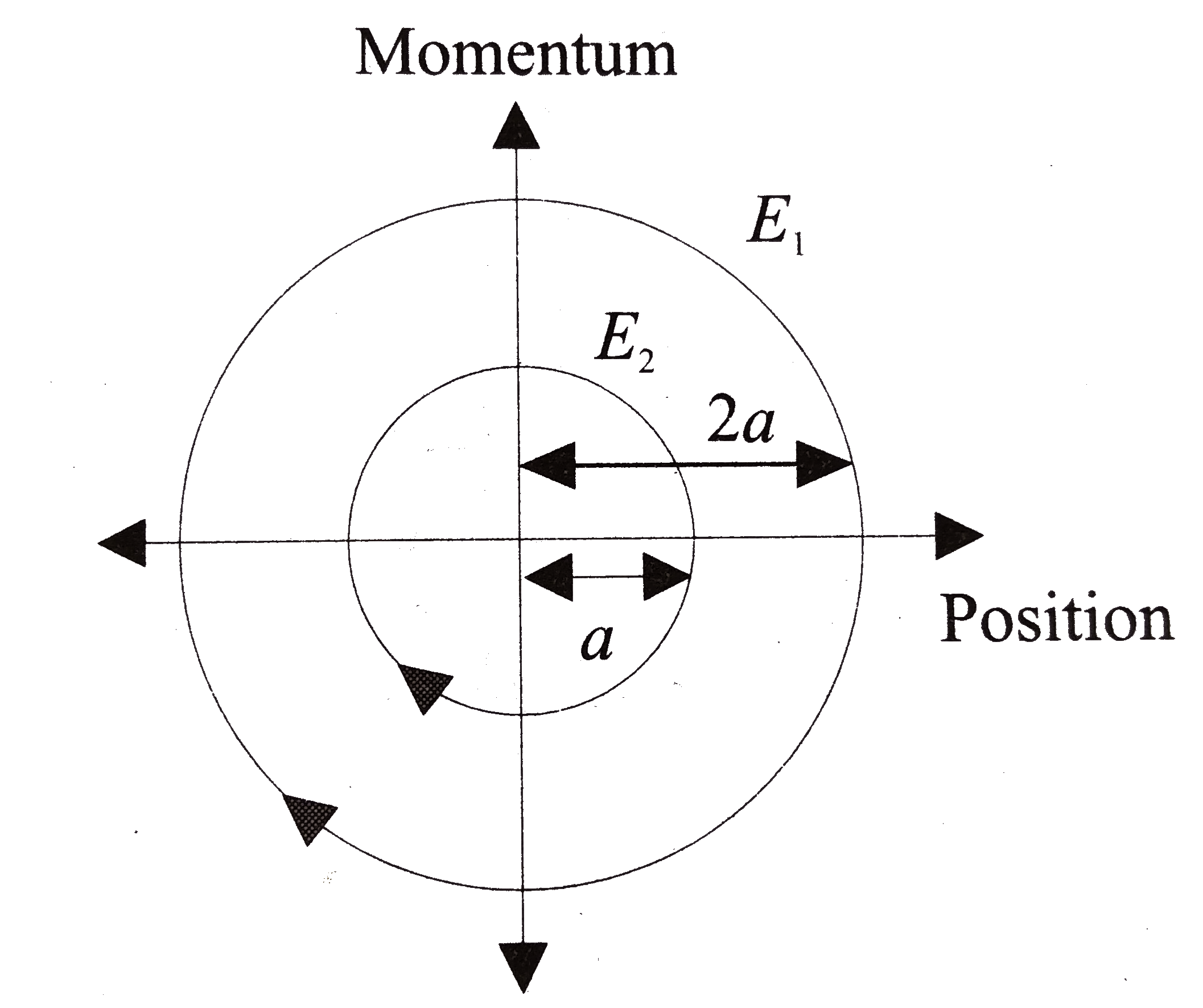 .03:25View Solution
.03:25View SolutionPhase space deagrams are useful tools
 .
.
in analyzing all kinds of dynamical problems. They are especially usrful in studying the changes in motion as initial position and momenum are changed. Here we conseder some simple dynamical systems in one dimension. For such systems, phase space is a plane in which position is plotted along horizontal axis and momentum is plotted along vertical axis. The phase space diagram is `x(t) vs. p(t) curve in this plane. The arrow on the curve indicates the time flow. For example, the phase space diagram for a particle moving with constant velocity is a straight line as shown in the figure. We use the sign convention in which positon or momentum upwards (or to right) is poitive and downwards (or to left) is negative.
The plase space deagram for simple harmonic motion is a circle centered at the origin. In the figure, the two circles represent the same oscillator but for different initial condetions, and E_(1) and E_(2) the total mechanical energies respectivey.
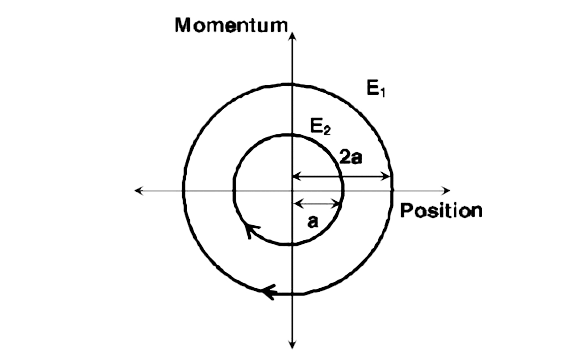 .03:25View Solution
.03:25View SolutionPhase space diagrams are useful tools in analysing all kinds of dynamical problems. They are especially useful in studying the changes in motion as initial position and momentum are changed. Here we consider some simple dynamical systems in one dimension. For such systems, phase space is a plane in which position is plotted along horizontal axis and momentum in plotted along vertical the axis.
The phase space diagram is `x(t)` vsersus `p(t)` curve in this plane. The arrow on the curve indicates the time flow. For example, the phase space space diagram for a particle moving with constant velocity is a straight line as shown in (Fig. 8.13). We use the sign convention in which position or momentum upwards (or to right) is positive and downwards (or to left) is negative.
 .
.
The phase space diagram for simple harmonic motion is a circle centred at the origin. In (Fig. 8.14), the two circles represent the same oscillator but for different initial conditions, and `E_1 and E_2` are the total mechanical energies respectively. Then.
 .03:25View Solution
.03:25View Solution
Comprehension questions and complete solutions for chapter ARCHIVES 2 VOLUME 6 of CENGAGE PHYSICS (ENGLISH) of Class 11
